HARRIS TR0001-E EDACS-300P User Manual 300P OpManual
HARRIS CORPORATION EDACS-300P 300P OpManual
HARRIS >
Contents
Users manual
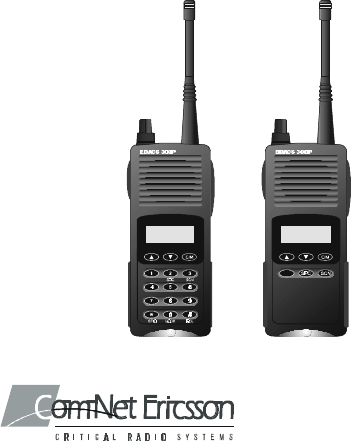
EN/LZT 123 5652/1 R1A
Operator’s Manual
EDACS 300P
System/Scan Portable
Radio

2
Table of Contents
User Interface.............................................................................. 3
Basic Operation .......................................................................... 6
Trunked Mode Operation............................................................ 8
Conventional Operation ........................................................... 13
Programmable Alert Tones ...................................................... 14
Error Messages......................................................................... 15
Changing the Battery Pack....................................................... 16
Operating Rules and Regulations............................................ 18
Intrinsically Safe Usage............................................................ 19
Operating Tips .......................................................................... 20
The software contained in this device is copyrighted by Com-Net
Ericsson. Unpublished rights are reserved under the copyright laws of
the United States.
NOTICE!
This manual is published by Com-Net Ericsson, without any warranty. Improvements
and changes to this manual necessitated by typographical errors, inaccuracies of current
information, or improvements to programs and/or equipment, may be made by Com-Net
Ericsson, at any time and without notice. Such changes will be incorporated into new
editions of this manual. No part of this manual may be reproduced or transmitted in any
form or by any means, electronic or mechanical, including photocopying and recording,
for any purpose, without the express written permission of Com-Net Ericsson.
Copyright © 2000 Com-Net Ericsson. All rights reserved.
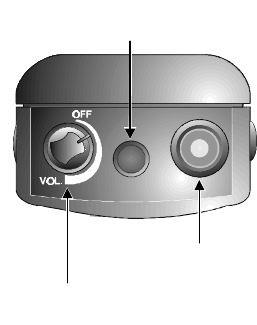
3
User Interface
This manual describes the basic functions and operation of
the EDACS 300P System/Scan portable radio. For more
detailed information about the features and operation, refer
to the appropriate EDACS 300P Maintenance Manual or
contact your System Administrator.
EMERGENCY/
HOME BUTTON
POWER ON/OFF
VOLUME KNOB
ANTENNA
Figure 1. EDACS 300P Top View
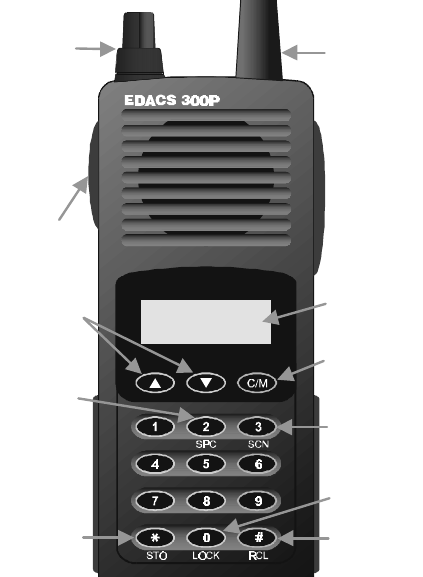
4
CLEAR/
MONITOR/
SHIFT
LOCK
ON/OFF
SCAN
ON/OFF
RECALL
DISPLAY
STORE
SPECIAL
CALLS
SELECT
SYSTEM/
GROUP/
CHANNEL
PTT
BUTTON
ON/OFF/
VOLUME ANTENNA
Figure 2. EDACS 300P System Model
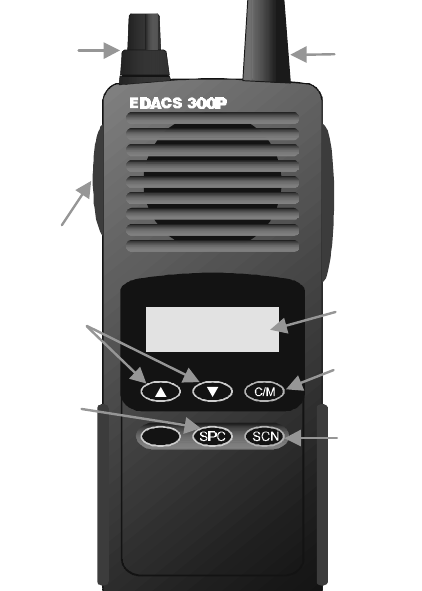
5
CLEAR/
MONITOR/
SHIFT
SCAN
ON/OFF
DISPLAY
SPECIAL
CALLS
SELECT
SYSTEM/
GROUP/
CHANNEL
PTT
BUTTON
ON/OFF/
VOLUME ANTENNA
Figure 3. EDACS 300P Scan Model
6
Basic Operation
Locking/Unlocking Keypad (System Model)
1. Press and hold the C/M key.
2. Press and release the LOCK key. Then release the
C/M key.
Selecting System
1. Press and release the C/M key. Then use the and
keys to select the desired system.
2. The SYS field displays the current System selected.
Selecting Group/Channel
1. Press the and keys to access the desired
group/channel.
Enabling/Disabling Scan
1. Press and release the SCN key to toggle Scan
ON/OFF. “SCN” is displayed when Scan is enabled.
Modifying Scan List
1. Select desired Group/Channel to be added/deleted. If
Group/Channel is currently in Scan list, “S” is
displayed.
2. Press and hold the C/M key.
3. Press and release the SCN key. Then release the
C/M key.
7
4. If selected Group/Channel was not in Scan list, it will
be added. If selected Group/Channel was in Scan list,
it will be deleted.
Home/Emergency Key Definition
Pressing the red Home/Emergency button will perform one
of the four operations below, depending upon how the
radio was programmed.
1. Radio will switch to the programmed home System
and/or Group, and send an emergency transmission.
2. Radio will send an emergency transmission on the
current System/Group.
3. Radio will switch to the home System and/or Group.
4. Button is not active.
Declaring Emergency
1. Press and hold the red Emergency/Home button (the
length of time is programmable; check with the System
Administrator).
2. If programmed, an “E” is displayed in the SYS field
and/or an alert tone sounds.
3. Press PTT button to transmit your message.
4. Release PTT button when transmission is complete.

8
Trunked Mode Operation
Transmitting a Call
Group Call
1. Select desired System and Group.
2. Ensure that no one is transmitting on selected Group
by observing display for absence of “BSY” indicator.
3. Press and hold PTT button.
4. When “TX” is displayed, speak into microphone.
5. Release PTT button when transmission is complete.
Wait for reply.
Individual Call
1. Press the SPC key. “S” and “PC” will be displayed.
2. The SYS field displays “SP”. The GRP field displays
the last accessed special call number from the
pre-programmed list.
3. Scan Model: Press the or keys to scroll through
the special call list until the desired number is
displayed.
System Model: Press the or keys to scroll through
the special call list until the desired number is
displayed; or
Enter the ID number of the radio to be called.
(To recall the last individual number entered, press
and hold C/M and then press the #/RCL key.)
4. Press and hold PTT button to initiate call.
5. When “TX” is displayed, speak into microphone.

9
6. Release PTT button when transmission is complete.
Wait for reply.
7. When call is complete, double click the C/M key to exit
Special Call mode.
Phone Call
1. Press the SPC key. “S” and “PC” will be displayed.
2. The SYS field displays “SP”. The GRP field displays
the last accessed special call number from the
pre-programmed list.
3. Scan Model: Press the or keys to scroll through
the special call list until the desired number is
displayed.
System Model: Press the or keys to scroll through
the special call list until the desired number is
displayed; or
Enter the telephone number to be called. Complete
the phone number entry by pressing the * key.
(To recall the last phone number entered, press and
hold C/M and then press the #/RCL key.)
4. Press and release PTT button to initiate call.
5. “BSY” is displayed and DTMF tones are sent.
6. When the receiving party answers the call, press and
hold PTT button and speak into microphone.
7. Release PTT button when transmission is complete.
Wait for reply.
8. When call is complete, press the C/M key twice to exit
Special Call mode.

10
Receiving a Call
1. Turn radio on and select desired System and Group;
or
Select desired System and then turn Scan ON (if
desired Group is in Scan List).
2. Radio is now ready to receive calls.
3. When call is received, radio unsquelches on assigned
channel and “BSY” is displayed. Depending upon the
programming of the radio, a tone may sound,
indicating the type of call received.
4. Group Call: If programmed, the Group ID of the caller
will be displayed in the SYS and GRP fields.
Individual Call: If programmed, the ID of the caller (or
just “id”) will be displayed in the SYS and GRP
fields.
Phone Call: “ph” will be displayed in the GRP field.
Emergency Call: “E” and the System number will blink
alternately in the SYS field.
5. Adjust the volume as necessary.
6. Respond by pressing PTT button and speaking into
microphone.

11
Storing/Recalling Numbers (System Model)
Storing Individual and Phone Numbers
1. Press the SPC key.
2. “S” and “PC” will be displayed.
3. The SYS field displays “SP”. The GRP field displays
the last accessed special call number from the
pre-programmed list.
4. Enter the ID number or phone number to be stored.
(To recall the last number manually entered from the
keypad, press and hold C/M and then press the #/RCL
key.)
5. Complete the entry by pressing the # key for an
individual number or the * key for a phone number.
6. Enter a digit from 0 to 9 to select a storage location.
7. Press and hold the C/M key and then press the */STO
key to complete the storage procedure.
8. Press the C/M key twice to exit Special Call mode
Recalling Stored Individual and Phone Numbers
1. Press the # key for an individual call or the * key for a
phone call.
2. Enter the desired storage location number (0-9).
3. Press and hold the C/M key and then press the #/RCL
key. The number will be displayed in the GRP field.
4. Individual Call: Press and hold the PTT button to
initiate the call. When signaling is complete, “TX”

12
and “BSY” are displayed and the Call Originate tone
sounds. Speak into the microphone.
Phone Call: Press and release the PTT button to
initiate the call. When signaling is complete, “BSY”
is displayed and DTMF tones are sent. When the
receiving party answers the call, press and hold the
PTT button and speak into microphone.
5. Release the PTT button when transmission is
complete. Wait for reply.
6. When call is complete, press the C/M key twice to exit
Special Call mode.
13
Conventional Operation
Transmitting a Call
1. Turn radio on and select desired System and Channel.
2. Ensure that no one is transmitting on selected Channel
by pressing the C/M key twice (to monitor channel)
and/or observing display for absence of “BSY”
indicator.
3. Press and hold PTT button and speak into the
microphone.
4. Release PTT button when transmission is complete.
Wait for reply.
Receiving a Call
1. Turn radio on and select desired System and Channel;
or
Select desired System and then turn Scan ON (if
desired Channel is in Scan List).
2. Radio is now ready to receive calls.
3. Press the C/M key twice to disable squelch and
monitor channel. Adjust volume to desired level.
4. When radio receives a call, radio is unsquelched and
message is heard.

14
Programmable Alert Tones
Name Tone Description
Power-Up (B) one Radio has passed self-test upon
power-up
Call
Originate (T) one short OK to talk; radio has acquired
channel
Call
Received (T) one
(Group)
one high, one
low (Indiv.)
Call has been received
Call
Queued (B) one short
high-pitched Call has been placed in queue for
processing
Autokey (B) one long
beep Queued call received channel
assignment
System
Busy (T) three short
medium-
pitched
System busy, all channels busy, or
receiving party engaged in call
Out of
Range/
System In-
operative
(T) one low-
pitched Radio out of range of repeater, or
radio inoperative
Call
Denied (B) one low-
pitched Radio is not authorized on the
system or group
Carrier
Control
Timer
(B) pulsed PTT pressed for pre-programmed
length of time. Release and re-key
PTT.
Low
Battery (B) one low-
pitched; 130
sec intervals
Low battery; needs charging
(T) = trunked mode only (B) = both trunked and conventional modes
15
Error Messages
E3 If at anytime the Synthesizer is unable to load and
lock on the channel properly, an "
E3
" message will
be displayed in the SYS field and the GRP field will
be blanked. If the "
E3
" message is displayed on all
Systems, the radio has failed or has not been
programmed properly. The radio's buttons and keys
will still operate with an "E3" message displayed.
E9 An "E9" message indicates that the Personality has
not been programmed into the radio.
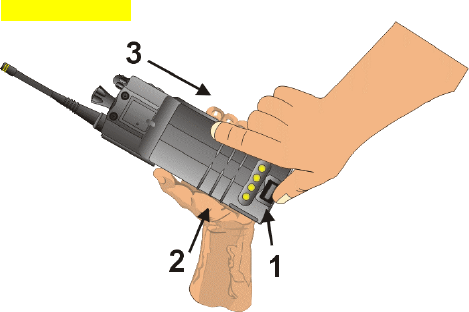
16
Changing the Battery Pack
When “BT” is displayed, or the display remains blank, the
battery is low and needs charging.
Removing the Battery Pack
Make sure the power to the radio is turned OFF.
1. Locate the latch on the bottom of the radio. Press and
hold the latch toward the back of the radio while sliding
the battery towards the bottom of the radio with your
other hand.
2. Remove the battery pack from the radio.
Replace graphic
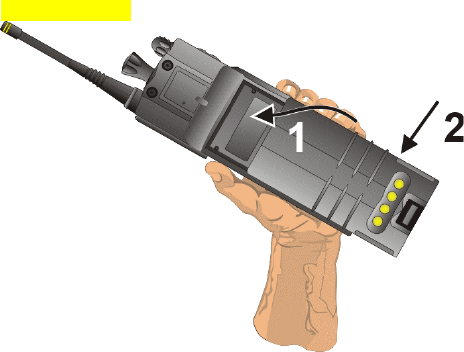
17
Attaching the Battery Pack
Make sure the power to the radio is turned OFF.
1. Align the tabs on the back of the radio with the slots on
the battery pack.
2. Slide the battery pack towards the top of the radio until
it clicks into place.
3. Verify that the battery pack is properly latched to the
radio.
Replace graphic
18
Operating Rules and Regulations
Two-way FM radio systems must be operated in
accordance with the rules and regulations of the Federal
Communications Commission (FCC). As an operator of
two-way radio equipment, you must be thoroughly familiar
with the rules that apply to your particular type of radio
operation. Following these rules will help eliminate
confusion and will assure the most efficient use of existing
radio channels. This will provide a smooth operating radio
network.
When using the radio, remember these rules:
1. It is a violation of FCC rules to interrupt any distress or
emergency message. As the radio operates in much
the same way as a telephone "party line", always listen
and/or observe the absence of the “BSY” display to
make sure that the line is clear before sending any
messages. If someone is sending an emergency
message, such as reporting a fire or asking for help in
an accident, KEEP OFF THE AIR! Emergency calls
have priority over all other messages.
2. Use of profane or obscene language is prohibited by
Federal Law.
3. It is against the law to send false call letters or a false
distress or emergency message.

19
4. The FCC requires that conversations be brief and
confined to business. To save time, use coded
messages whenever possible.
5. Using the radio to send personal messages (except in
an emergency) is a violation of FCC rules. Send only
those messages essential for the business operation.
6. It is against the Federal law to repeat or otherwise
make known anything overheard on the radio.
Conversations between others sharing your channel
must be regarded as confidential.
Intrinsically Safe Usage
Selected portable radios with appropriate factory installed
Options are certified as Intrinsically Safe by the Factory
Mutual Research Corporation.
TBD
20
Operating Tips
The following conditions tend to reduce the effective range
of two-way radios and should be avoided whenever
possible.
•Operating the radio in low terrain areas or while under
power lines or bridges.
•Operating the radio inside of a vehicle or inside metal
or steel framed building unless using an outside
antenna.
21
NOTES
22
NOTES
23